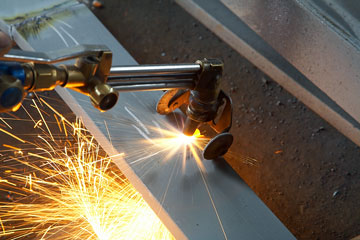Metalworking Guide and Directory
Regional Directory > Metalworking > Metalworking News
Metalworking Firm Directory |
 Many common household appliances such as stoves, refrigerators, and dishwashers
all contain various types of metal. Schools, houses, office
buildings, and other structures contain pipes, rods, beams, and other
metal components. The discovery of metals and the practice of
metalworking have been partially responsible for the growth of railroads,
advances in military technology, the invention of the automobile, the
growth of large cities and expansion of highway systems, and advances in
the air and space industries.
Many common household appliances such as stoves, refrigerators, and dishwashers
all contain various types of metal. Schools, houses, office
buildings, and other structures contain pipes, rods, beams, and other
metal components. The discovery of metals and the practice of
metalworking have been partially responsible for the growth of railroads,
advances in military technology, the invention of the automobile, the
growth of large cities and expansion of highway systems, and advances in
the air and space industries.
Metalworkers work with various metals and are responsible for helping to create many of the things we take for granted in our modern society. Metalworking careers exist in the areas of sheet-metal, machining and machine operation, structural and reinforcing metalworking, welding, and jewelry making. Sheet-metal workers make, install, and repair items using sheet metal, such as hangars, aluminum siding, and outdoor signs. Machinists and machine operators produce precision steel, copper, iron, aluminum, metal alloy, or plastic parts to meet detailed specifications. Machinists make or repair items in small quantities, while machine operators produce items in larger quantities on an assembly line. Structural and reinforcing metalworkers are often referred to as ironworkers; they assemble the steel or iron framework of buildings, bridges, and other structures. Welders specialize in joining together metals with heat and other processes. They utilize electric current, gas, laser or electron beams to connect pieces of metal for use in ships, airplanes, automobiles, highways, bridges, and buildings. Jewelers work in a variety of settings and produce and repair rings, bracelets, earrings, necklaces, and other types of jewelry. Most metalworking careers can be entered into through internships or specialized training, but do not require a four year degree.
More information about careers in metalworking can be found at the International Training Institute for the Sheet Metal and Air Conditioning Industry, the Machinist Career Guide, and the American Welding Society and National Center for Welding Education & Training.